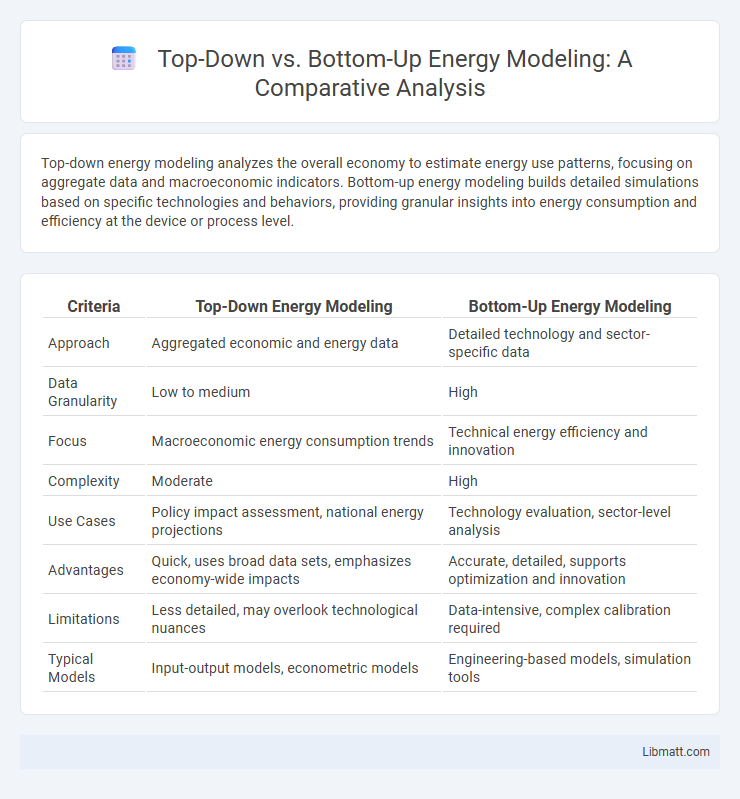Top-down energy modeling analyzes the overall economy to estimate energy use patterns, focusing on aggregate data and macroeconomic indicators. Bottom-up energy modeling builds detailed simulations based on specific technologies and behaviors, providing granular insights into energy consumption and efficiency at the device or process level.
Table of Comparison
| Criteria | Top-Down Energy Modeling | Bottom-Up Energy Modeling |
|---|---|---|
| Approach | Aggregated economic and energy data | Detailed technology and sector-specific data |
| Data Granularity | Low to medium | High |
| Focus | Macroeconomic energy consumption trends | Technical energy efficiency and innovation |
| Complexity | Moderate | High |
| Use Cases | Policy impact assessment, national energy projections | Technology evaluation, sector-level analysis |
| Advantages | Quick, uses broad data sets, emphasizes economy-wide impacts | Accurate, detailed, supports optimization and innovation |
| Limitations | Less detailed, may overlook technological nuances | Data-intensive, complex calibration required |
| Typical Models | Input-output models, econometric models | Engineering-based models, simulation tools |
Introduction to Energy Modeling Approaches
Top-Down and Bottom-Up energy modeling approaches offer distinct frameworks for analyzing energy systems and forecasting demand. Top-Down models use aggregate economic data to estimate energy consumption patterns, emphasizing macroeconomic variables and sectoral energy intensities. Bottom-Up models build detailed representations of energy technologies and processes, enabling You to assess specific efficiency improvements and policy impacts at the component or system level.
Defining Top-Down Energy Modeling
Top-Down Energy Modeling analyzes energy consumption at a macroeconomic level by examining aggregate data such as national energy statistics, economic indicators, and sectoral energy use. It employs econometric methods to derive relationships between energy demand and economic factors, enabling estimation of overall energy consumption trends and forecasting future needs. This approach provides broad insights into energy patterns, guiding policy decisions without requiring detailed technological data.
Defining Bottom-Up Energy Modeling
Bottom-up energy modeling builds complexity from detailed individual components and processes, such as appliances, industrial machinery, or building systems, to estimate overall energy consumption. This approach uses granular data inputs and engineering principles to simulate energy use at micro-levels, enabling precise scenario analysis and behavioral impact assessment. It contrasts with top-down models by emphasizing physical details and technological specifics to forecast energy demand and efficiency improvements.
Key Differences Between Top-Down and Bottom-Up Models
Top-down energy modeling relies on macroeconomic data and aggregated energy consumption trends, emphasizing economy-wide indicators such as GDP and price elasticities. Bottom-up models build from detailed technological, sectoral data, focusing on specific energy technologies, infrastructure, and efficiency measures to predict energy patterns. The key difference lies in top-down models capturing broad economic interactions, while bottom-up models provide granular insights on technology and behavior changes.
Data Requirements and Sources
Top-down energy modeling relies heavily on aggregated macroeconomic and sectoral data from national statistics, energy consumption reports, and economic output records, enabling broad analysis of energy trends. Bottom-up models require detailed, disaggregated data such as individual technology performance, equipment efficiency, and operational specifics sourced from technology databases, industrial surveys, and engineering studies for precise simulation of energy use. Integrating accurate and comprehensive data sets significantly impacts the reliability of both approaches in forecasting energy demand and assessing policy impacts.
Strengths of Top-Down Energy Modeling
Top-Down Energy Modeling excels in utilizing macroeconomic data to capture large-scale energy consumption patterns, providing a comprehensive view of national or regional energy trends. This approach benefits from its ability to integrate economic indicators, policy impacts, and technological changes, enabling policymakers to forecast energy demand with broad accuracy. Your strategic decisions can leverage Top-Down models to assess long-term energy implications within complex economic systems.
Strengths of Bottom-Up Energy Modeling
Bottom-up energy modeling excels in its detailed approach, breaking down energy consumption by specific technologies, sectors, and end-uses to provide accurate, granular insights. This method allows you to analyze the impact of individual efficiency measures and technology adoption on overall energy demand with high precision. Its strength lies in capturing technological innovation and policy changes at a micro level, enabling tailored strategies for optimizing energy use and reducing emissions effectively.
Common Applications in Energy Policy and Planning
Top-down energy modeling is commonly used in national energy policy analysis, allowing policymakers to assess the broad economic impacts of energy regulations and forecast overall energy demand based on macroeconomic variables. Bottom-up models are favored in detailed energy planning, providing granular insights into technology-specific efficiencies, investment costs, and sectoral energy use, which helps in designing targeted interventions such as renewable energy integration or energy efficiency programs. Your choice between these approaches depends on whether the focus is on high-level economic trends or detailed technological scenarios for effective energy policy and planning.
Limitations and Challenges of Each Approach
Top-Down energy modeling faces limitations in capturing detailed sector-specific behaviors and technological advancements due to its reliance on aggregate economic data and broad assumptions. Bottom-Up models struggle with high data requirements, model complexity, and computational intensity, often leading to oversimplifications that can affect accuracy. Both approaches encounter challenges in integrating real-time data and accounting for policy shifts, making hybrid methods increasingly necessary for comprehensive energy analysis.
Choosing the Right Energy Modeling Method
Choosing the right energy modeling method depends on your project's complexity and data availability, where top-down models analyze aggregated energy consumption trends from macro-level data, while bottom-up models build detailed simulations based on individual components and technologies. Bottom-up approaches offer granular insights for designing energy-efficient systems, whereas top-down methods excel in forecasting and policy analysis by leveraging historical energy use patterns. Assess your data precision and modeling goals to determine which method aligns best with your energy planning needs.
Top-Down vs Bottom-Up Energy Modeling Infographic

 libmatt.com
libmatt.com